
35 minute read
Welcome
from the head of school
Reflecting on Resilience in 2020
Over the past year or so, I have been writing fairly regular reflections for the weekly newsletter that Harvey sends out to our families. As you might imagine, many of my pieces focused on the pandemic and our school community’s response to challenges and changes it brought. In keeping with the theme of this magazine, I often highlighted the resilience demonstrated by our students, our faculty and staff, and our families in the face of these unprecedented times. We commonly think of resilience in this way, as the ability to confront difficult situations and adapt and persevere. We imagine people struggling with hardship and not giving up, falling down and getting back up, or failing repeatedly before finally overcoming adversity. In this context, resilience equates to grit. Toughness. Tenacity. Indomitable spirit. Although those are certainly all accurate and useful descriptions of resilience, I want to explore a more nuanced aspect of the concept that has emerged during these past months as well. In my last reflection for 2020, I shared a story about an interaction I had with a student in November when I was meeting students as they arrived on campus to start the day. The first student I saw that morning had been forced to quarantine for two weeks because of a positive case of COVID-19 on campus. As I welcomed him back to campus, he greeted me and exclaimed, “I will never take this place for granted again.”
Most likely this student, like other students, had imagined over the years all the places he would rather be than in school. How many of us have not at one point or another longed to be somewhere other than where we are? But living through this pandemic has turned our world upside down and taught us how tenuous our grip can be on all that we take for granted.
As I have reflected on the genuine sincerity of his utterance, I have come to understand his words as expressing another aspect of resilience. Resilience is not just about overcoming adversity and continuing on. It is also defined by an ability to see light inside of darkness or find value and beauty in the previously commonplace or mundane.
Resilience is ultimately about the choices we make. Do I give up or carry on? Do I choose to look for the bright side and silver linings or focus on the hardships and unwelcome change? Resilience is about finding ways to thrive even when simple survival may feel like enough.
During these past months, I have watched our students and teachers come together to push through the challenges and disappointments brought by the pandemic to find community and learning and even joy. As you read through the pages that follow, I hope you are struck as I have been by the many faces of resilience at The Harvey School.
With kind regards,
William J. Knauer, Head of School
Although we will no doubt face setbacks along the way, we are compelled forward by the conviction that school is integral to the well-being of children and their families.” - Bill Knauer, Head of School
Uncharted Territory

By Karen Grazia School Reopening 2020
As the COVID-19 pandemic swept across the country, The Harvey School, like many others, closed campus in mid-March 2020 and turned to remote learning for the remainder of the school year. During the summer, the shared goal of the Harvey administration was to reopen campus on time in September for the 2020–21 school year. This would be no easy task. Harvey’s leadership team worked closely with the Board of Trustees, faculty, staff, and families to prepare for the reopening, creating the Reopening Task Force (RTF) to provide the framework of what that would look like (see ‘Meet the RTF’ page 12). “Protecting and supporting both the physical and emotional health and well-being of our community was our fundamental reopening priority,” said Bill Knauer, head of school.

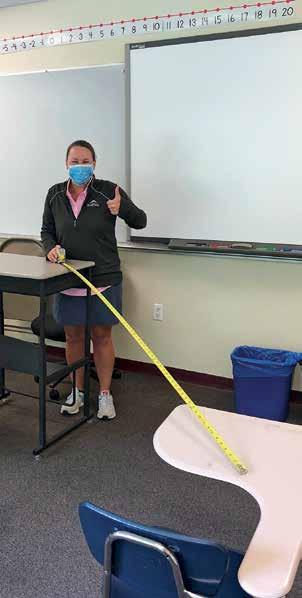
Together We Can
To develop the most vigorous academic program possible to meet the needs of all students; in-person, remote, and hybrid, Upper and Middle School administrators spent the summer reflecting on what worked and didn’t work during remote learning in the spring. Exploring different options regarding classroom setup, student schedules, and increased time between classes for students to safely navigate the hallways, as well as reenvisioning shared spaces for lunch and flex periods, required flexibility and resourcefulness.
“The mathematical logistics of working through every student schedule to incorporate social distancing and maximize space was a challenge,” said Phil Lazzaro, head of Upper School. Thinking about ways to utilize space as efficiently as possible allowed the team to imagine different possibilities to move their plan forward. Spaces such as the library, Black Box, and choral rooms were brought into the academic rotation to maximize space. “Each new student schedule created after August 1 forced us to shuffle rooms and assignments to reestablish room capacities and set safe distances between student desks,” Mr. Lazzaro said.
“Even though it may take a bit until the world is completely back to normal, I think Harvey has done a great job with leading
Harvey Teachers: Purpose Fuels Passion
Teachers across the country are the unsung
heroes of the pandemic, and the Harvey faculty is no exception. So it was not surprising when all faculty members returned to campus this past fall, prepared to take their place in front of the classroom, in advisory, at lunch, during flex periods, essential workers committed to making it possible for students to return to campus after a spring term of remote learning and quarantining.
Since we don’t know what will happen during the remainder of the 2020–21 school year, we want to share the dedication, creativity, and passion of our teachers in the classroom, as well as the kindness and resilience of our students. This spirit is what unites the Harvey community and keeps us strong.

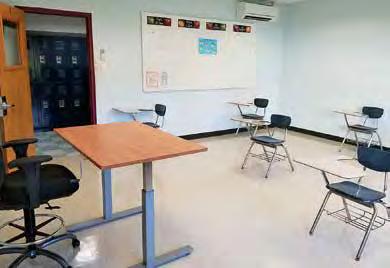
us down the path to get back to this point,” said Harvey junior Amanda Mohamad. “I’m glad to still be able to take the classes I’m interested in, even with social distancing guidelines. Classes are still discussion-based as they were before COVID-19, which is how I believe I thrive the most academically.”
“Teachers independently researched ways to improve instruction,” said Dr. Brendan Byrne, head of the Middle School. “A huge advantage for our school is that we had a number of teachers work at the Harvey Summer Camp, and they became familiar with new safety protocols when working with students. Teachers also prepped on how to utilize outdoor learning spaces and new technology.”
“Being back in class and on campus is great,” said eighth grader Jonathan Bailey. “I get to see all of my friends again, and I don’t have to be in front of a screen all day. Now that we are back, learning is so much easier.”
“The response of the teaching and administrative faculty in their commitment to reopening was extremely helpful in the success of opening the school this past fall,” said Linda Cioffi, RTF member and Harvey parent. “They all worked tirelessly during the summer to make this happen, and we are a grateful Harvey community.” Wearing a mask and social distancing are the most apparent changes on returning to school. But precautions like these are not difficult to follow and are necessary to keep everyone healthy and safe.” - Giselle Groff, junior
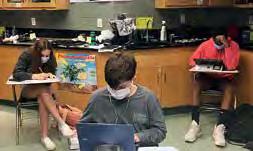
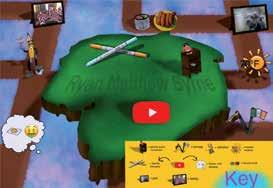

Mrs. Alexander’s English 8 students use the topic of identity to create an image that depicts who each student is as a person. Details include likes, dislikes, hopes, dreams, heritage, favorite songs, important experiences, and more. The challenge was to design a picture in the form of a map using any medium of their choosing.
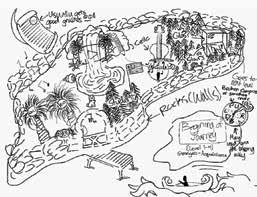
Innovative Planning & Technology
Starting in July, step one was redesigning the classrooms and learning environment. “Harvey gave students and parents a choice,” said John Wahlers, head of technology. “Students could opt for in-person, remote, or hybrid,” said Mr. Wahlers, who had the Herculean task over the summer of outfitting 60 classrooms with webcams, speakers, and microphones to allow students to Zoom into live classes and have the same experience as those students learning in person. Since many classes at Harvey are interactive, a traditional, mounted fixed setup would not allow teachers to provide the same classroom experience.
“I had an idea for mounting the webcam on a tripod and making the equipment mobile,” said Mr. Wahlers. Art, dance, robotics, math, and science are all classes that need a flexible setup. “The tripod-mounted webcam allows teachers to place the equipment anywhere in the classroom to meet student needs and serve the individual instructional style of each teacher,” said Mr. Wahlers, who did extensive research on webcams, microphones, speakers, tripods, cables, and adapters to tie everything together.
Ordering from a dozen different vendors, he managed to secure 60 sets of equipment to ensure the same setup for each classroom as teachers would be moving from classroom to classroom, depending on class size. Classroom setup for Zoom took hundreds of hours of research, design, testing, demonstration, and training.
Middle School students have 15-minute breaks between classes, allowing them time to go outside and stretch their legs, release some energy, and laugh with their friends. They come back into class ready and eager to work. Upper School students also have time during flex periods to play tennis and get some outdoor recreation between classes.
Both in-person and remote students experiment with angles and launch projectiles in Mr. Kelly’s Upper
School physics class.

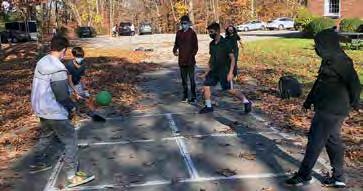
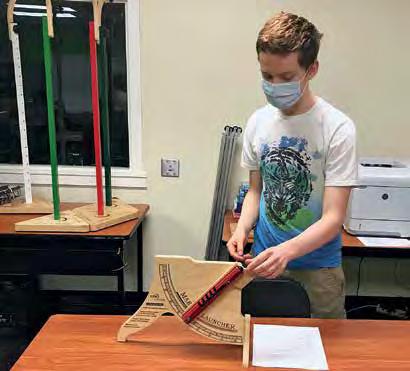
How is it working?
“Students learning in person interact with remote students by welcoming them to class each day,” shared Middle School English teacher Cris Alexander, who explained: “Remote students use the chat feature on Zoom to ask questions and share ideas. I check in verbally with remote students during the lesson, just as I do with the in-person students.”
“We have a few eighth graders who are remote learners,” said Middle School science teacher Marcie Hajem. “So each time we do a lab, I partner them up with a different student so they can get to know each of the kids in their class.”
“With cameras incorporated into the classroom, remote students actually feel like they are in school,” said senior Densley Blake. “I am a hybrid student, so being able to see the board or the classroom is really helpful.”
“My biology students completed an enzyme lab as a simulation in Google Slides,” said Upper School science teacher Melissa Zeffer. “This is done as a safer and more inclusive alternative to the traditional lab. As a whole, the science department is being creative in offering lab and demonstration experiences that are authentic and safe for our students.”
Mr. Wright and his chorus students
spread out in Lasdon Theater, keeping a safe distance apart to practice singing.
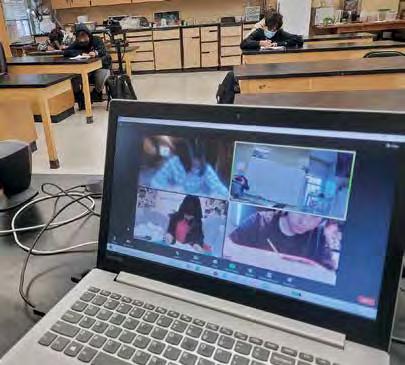
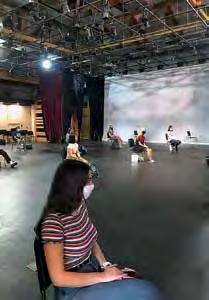

Resourcefulness
in Middle School
As part of Harvey’s reopening process, Dr. Brendan Byrne looked to see what colleges were planning, and the idea bubbled up to provide all Middle School students with portable chairs and lunch coolers as a good safety measure to prevent the spread of COVID-19. Turns out, this initiative also has an environmental benefit. “By our Middle School students and staff using reusable lunch coolers, we avoided wasting nearly 2,000 paper bags during just the fall term alone,” said Dr. Byrne.
In-person and remote students take a test together in Mr. Cornell’s Japanese 2 class.
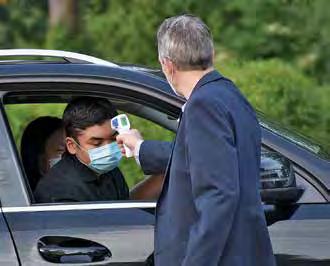
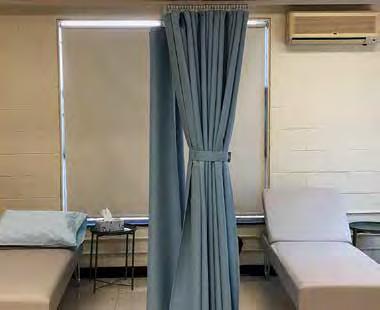
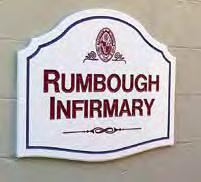
Staying Safe On Campus
New protocol requires that all students, faculty, and staff submit a COVID Quick Screening health assessment each morning, as well as undergo a temperature check when arriving on campus. “Mr. Knauer is still warmly greeting everyone in the morning. He just added a thermometer to his morning routine,” said Harvey junior Evan Goldblum, humorously adding, “so now he just has to make sure his warm greeting doesn’t get above 100 degrees.” Harvey also committed to requiring the entire community to wear masks and maintain social distancing of six feet from others while on campus. “We adopted a layered approach to health and safety to protect our students, staff, and families while creating an environment of meaningful interaction,” said Mr. Knauer.
The entire community has stepped up to follow the new rules to keep the Harvey campus as safe as possible. “As long as I get to be in school and around people, I will wear my mask,” said eighth grader Emily Sorio. “I think the mask is a smart idea and works really well. I’m glad that people wear them for our safety and theirs.”
This pandemic has brought increased patience and caring with one another into our student population. If a student is struggling emotionally, their classmates cheer them up and empathize with them. Human kindness is not lost; it’s sitting at a desk in our classroom.” - Marcie Hajem, science teacher
Ms. Zeffer and Ms. Hajem’s Upper School
biology students use the iNaturalist app to help them identify plants, fungus, insects, animals, birds, and other species on the Harvey campus.
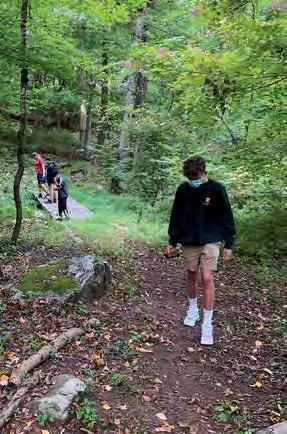

A New Infirmary
During the summer, the school infirmary was moved to a more centralized location with an outdoor entrance next to Carter Hall, near the Commons, providing easier access for emergency services. “Our preparations began in July with Zoom meetings with our medical director, Dr. Louis Corsaro, to discuss protocols and procedures,” said nurse Kerby Lewis. Evening nurse Dolores Orchanian purchased supplies and packed up the entire infirmary during the summer before the move. Nurse Lewis also enlisted the help of retired nurse Pat Pollack, who helped transition the health office from paper medical records to the all-digital Magnus system.
“The new infirmary setup has been working really well,” said Nurse Lewis. “We have a reception area with an air filter system that has an entrance from the outside of the building. The reception area has two isolation rooms built off it and then an entrance to a clean working space where we can tend to students who are symptomfree. We are stocked up with cleaning supplies and personal protective equipment (PPE) to keep our students and infirmary staff protected.”
As part of their mythology projects,
Latin 1 middle
schoolers present the gods and goddesses they researched to their classmates and their teacher, Dr. Moser.
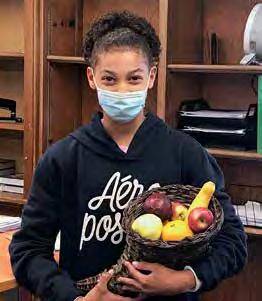
The Road to College During COVID-19
By Meg Booth Director of College Counseling
While much in the world was different this fall, Harvey seniors continued to think toward the future and were very busy moving forward with the college application process. Their focus and drive to complete applications during this challenging time demonstrated the exceptional adaptability and resilience of Harvey students. Impressively, and with great creativity, the seniors managed to continue to engage in a variety of activities of interest outside the classroom, ranging from virtual community service to filmmaking, to personal athletic training.
The College Counseling Office was busy meeting both in person and virtually with the seniors through individual advising meetings to work on all parts of their applications from general guidance to essay writing and interview prep. To prepare for interviews that were all virtual this year, the college counselors shared tips and best practices for online interactions. Since there were limited opportunities for students to visit campuses, we facilitated online engagements with the colleges for seniors. Throughout September and October, a record number of college admissions reps (up to seven a day) “visited” Harvey through virtual meetings. Despite these changes, the timeline remained the same. With January having arrived, seniors now have the college application process behind them!
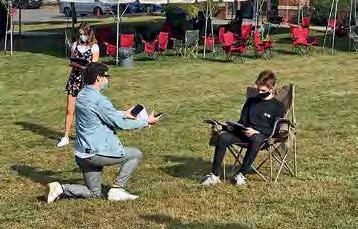
Ms. Falcon’s Upper School history students take their classroom outside on the Quad to conduct a feudalism simulation, with each student assigned a role as either a king, lord, knight, or serf.
Harvey created a Reopening Task Force (RTF) composed of a dedicated group of current and former parents, trustees, and staff with considerable expertise in the areas of medicine, mental health, safety, logistics, law, compliance, and equity and inclusion. Together, the school and the RTF developed a reopening plan in accordance with local, state, and federal guidelines and requirements.
RTF Chair J. Eric Wise first came to Harvey as a parent 10 years ago, wondering if Harvey would be a good fit for his son John. “It became very clear that John’s personal relationships with his teachers and classmates were leading to increasing success and happiness for my son,” said Eric. “I have always been very grateful for that.” His experience is what motivated Eric to get involved with formulating Harvey’s reopening plan. “I had deep reservations about protracted remote learning for students. I was delighted to have the opportunity to do what I could to help The Harvey School get back to in-person, on-campus learning to the greatest extent possible,” he said.
“The goal was the safe return of students to in-person learning, with an option for hybrid and remote learning that would exceed the delivery of online learning launched in the spring during the onset of the pandemic,” shared Linda Cioffi, RTF member. “Bill Knauer had tremendous insight and provided the team with guidance as we navigated the various areas to be addressed. His focus on the ‘layered’ approach was brilliant and has been effective in maintaining a safe environment.”
“The RTF worked until the narrow path to reopen was identified, and then we cleared the area around that path so that students would be safe and well and still learning and growing, through in-person and on-campus learning, if that is what they chose to do,” said Dawanna Veneable, Harvey parent and RTF member. “Not only did we address the most obvious health and safety issues, but also we endeavored to protect the whole student, no matter who they are, where they are in our broader geographic area, and what their particular set of circumstances may be.”
Greg Phillips, the school safety coordinator, had not only the responsibility of supplying Harvey with PPE, which included thousands of masks, plastic face shields, and protective clothing for the nurses, but also everything else that was needed to reopen campus safely and protect the entire community.
Here are just some of the purchases and upgrades for Fall 2020:
• Upgraded HVAC filters to MERV 13 or better • Touchless water faucets and water dispensers • New air conditioning systems • Ultraviolet wands and UV lights • Viking Electrostatic cleaning devices • Plastic dividers • Thermometers • Hand sanitizer and dispensers • Classroom sanitizer • Tables for use in athletic center • Outdoor tents and chairs • Increased internet capacity on campus
We thank our RTF members for their commitment to our school:
• J. Eric Wise (chair) • Leslie Berni • Linda Cioffi • Dr. Jill Cohen-Ostrager • Valerie Nelson • Dr. Jennifer Powell Lunder • Greg Phillips • Dawanna Veneable • In consultation with medical director Dr. Louis A. Corsaro
Senior Bridge
classes utilize the entire campus to practice leadership activities and interviewing skills for college admission.
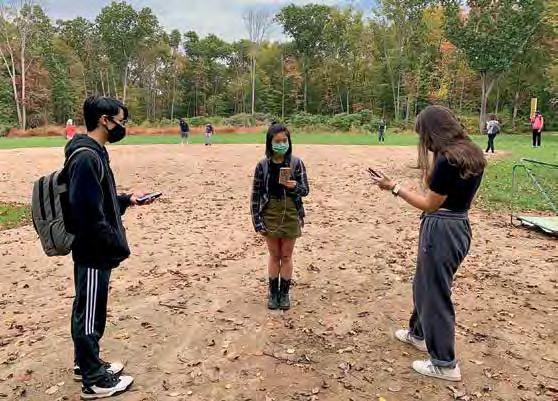
Taking Each Day As it Comes
Harvey reopened the week of September 8 with all students on campus together September 11. “I suspect that for many of us, the hardest part of returning to campus was the fear of the unknown. Now we have crossed the threshold,” said Mr. Knauer. “I have watched the initial fear and trepidation melt away, revealing hope and even joy. We continue to navigate through uncharted territory, compelled forward by the conviction that school is integral to the well-being of children and their families. That has been our North Star, guiding us, inspiring us, and leading us toward reopening in the face of such uncertainty.” Every single day teachers step on campus is a moment of resilience. I think ‘courageous’ is the word that best captures what teachers are doing.” - Dr. Brendan Byrne, head of middle school


Ms. Lindquist adapts to teaching one in-person student and the rest Zooming in to her English Language Workshop 2 class.
Students in eighth
grade science class
with Mr. Janos test out their science, technology, engineering, art, and mathematics (STEAM) projects. They researched, designed, and built their own cardboard chairs.
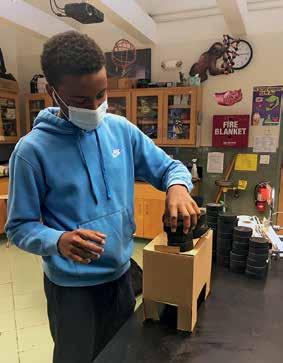
— ALEX EDWARDS-BOURDREZ ’68
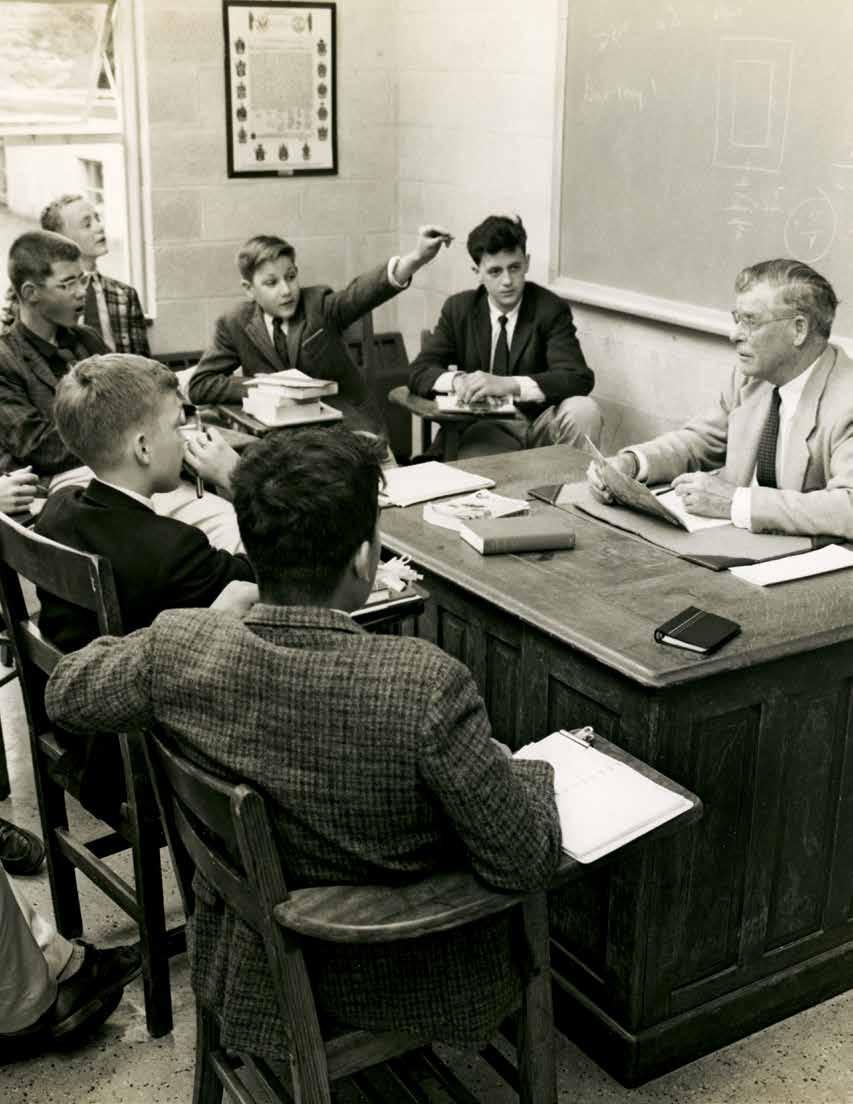

Harvey Middle School Weaving Its ‘Magic’ Throughout the Years
By Chris Del Campo
There’s a certain amount of dread that many parents feel when their children are about to leave the cocoon of elementary school and make their way into the brave new world of middle school. It is a transition from the “Let me show you how” K–5 years to the next phase when children’s cognitive abilities are increasing while they’re searching for their identity in a more complex social environment. Many parents of our middle schoolers during the years, when reflecting on their child’s grades six to eight educational experiences, talk about “the Harvey magic.” They appreciate that Harvey Middle School provides a learning environment that not only guides young adolescents through this important developmental stage in their lives but also sparks their curiosity to explore, encourages them to take risks, and helps them grow to be more self-assured young adults by the time they celebrate their Eighth Grade Moving Up Day.
Harvey’s Middle School has been getting it right for many years. Just ask Alexander Edwards-Bourdrez ’68, who recalls his middle school years with much fondness. Alex, who was three years too early to be able to stay at Harvey beyond eighth grade (ninth grade was added in the 1970–71 school year), remembers his days as a boarding student in seventh and eighth grades as a time when his teachers “exuded authority and caring.” Alex pointed out that during his time, Harvey called seventh grade Fourth Form and eighth grade, Fifth Form, as the school was still modeling itself after the traditional British boarding school for boys. He
Opposite. Harvey teacher Mr. Mitchell Lyon (1945–63) with students // Top. Alex, first row, third from right, in Fifth Form class picture // Above. Boys reading in the Fifth Form garden outside Sylvan Hall // Right. Alex in eighth grade in 1968, and today


Above Right. Alex and friend, Harry Minot ’68, in dorms in 1967 // Above Middle. A snowy Harvey campus in 1967 // Right. Harvey faculty pose for a photo in 1960. // Bottom. An all-school photo of students and faculty in 1968 // Opposite. 1960s Harvey students absorbed in their studies
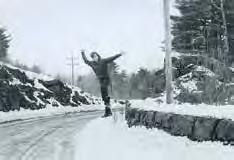
remembers that he and his fellow Fifth Formers felt like they were “kings of the hill,” feeling proud not simply for being the oldest but for achieving success in their schoolwork. “We always strove to do better, and most of the time, we could feel proud of what we were accomplishing,” Alex said. “That doesn’t happen without the student-focused fuel of great teaching and leadership,” he added.
So much of what Alex says about his seventh and eighth grade days more than 50 years ago is remarkably true today. In describing today’s Harvey Middle School, division head Dr. Brendan Byrne’s words reflect those of Alex: “It’s about learning and providing our students with opportunities where there is rigor, where there is challenge, and also where there are opportunities to connect with teachers, to receive support they might benefit from, to be self-advocates, and to become independent learners,” Dr. Byrne said.
Speaking of his time in the late 1960s, Alex seems to be describing today’s Harvey. “I could not imagine a more thorough and stimulating academic training combined with such purposeful attention to developing young people as confident individuals in a tight community setting,” Alex said. In addition to setting high expectations for their students in terms of both study and behavior, “the teachers,” Alex said, “recognized the sensibilities and needs of our age group, which made for a significant growing experience in all areas of school life.”
When Alex recalls his Harvey teachers, he does so with a deep appreciation for the way they helped foster a great sense of community, a value that remains as important today as it was in Alex’s time as a boarding student. “To have kids experience community at a young age is really important,” said Dr. Byrne. “It means you are a citizen of this community, where each of us looks after one another, and a student is part of a class of 10 or 11 others; in addition, the teacher expects you to contribute every day,” Dr. Byrne said, adding, “So there’s that incentive to be prepared for class, to do your homework, to prepare for assessments because you’re in this community. … It’s not just an individual experience.”
One of the other hallmarks of Harvey Middle School is its long-established practice of encouraging its students to take risks, to make some decisions for themselves, to find their own voice, all with a strong support system of caring and dedicated staff who know that middle school-age children typically struggle with things like insecurities, self-esteem, and identity. Harvey’s Head of School Bill Knauer calls the middle school years a “key experience in a child’s development.” He said, “Middle school is that transition from childhood to adolescence, to adulthood, and if that’s a positive experience, there’s a greater chance that what’s to follow will be positive and successful as well.”
Alex credits his Harvey teachers with helping him mature and with preparing him for what awaited him after completing
(continued on page 19)

— HEAD OF SCHOOL BILL KNAUER

Inspiring Students since 1965:
The Hickrill Science Building
In 1965, The Harvey School purchased The Hickrill property, which included an old brick laboratory that is now part of the current day Middle School. The laboratory has an interesting history.
The Hickrill building and laboratory was well-known during the 1950s as a center for pure organic chemical research with an emphasis on cancer studies. Built by the founders of the Hickrill Research Foundation, the late Sylvan Weil and his wife, Mrs. Robert Halsband, the laboratory attracted scientists and students from all over the world. The great chemists Dr. William Doering and Dr. Lawrence Knox, together with Mrs. Halsband, prepared in this building the first aromatic seven-part non-benzine synthetic compound known as tropolone, which paved the way for a new field in non-benzine aromatic chemistry.
The Hickrill building was renovated into an elementary school facility in 1966, with a photography darkroom, reading reference area, science labs, music rooms for large groups and individual instrumental practice, and a hobby shop for weekend activities and projects. The attached 27 wooded acres provide the nature trails that exist around the Harvey Middle School. In 2002, six additional rooms were added, and the building was renamed the Krasne Middle School.
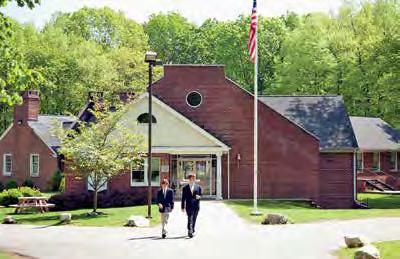
— ALEX EDWARDS-BOURDREZ ’68
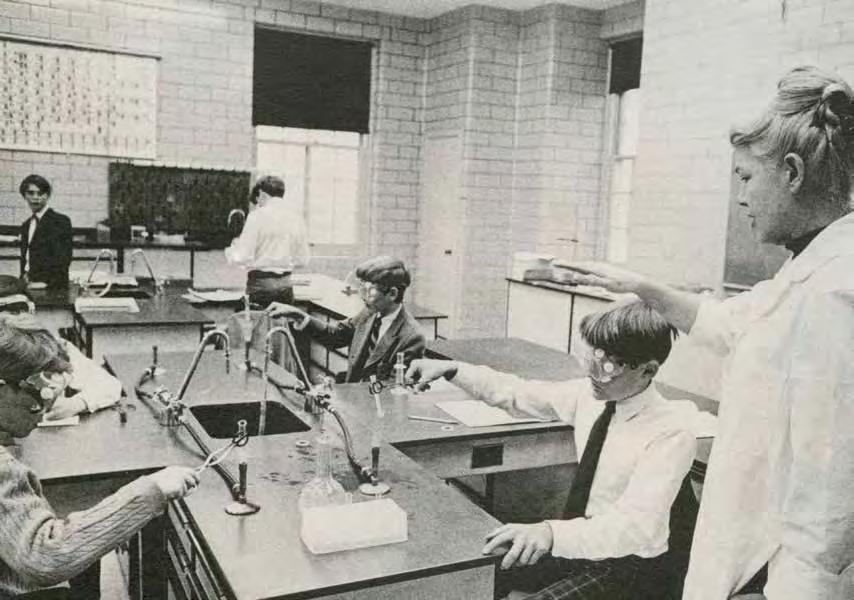

(continued from page 16)
the eighth grade. Unlike today’s Harvey eighth graders who can remain in familiar surroundings and move up to the Upper School, Alex did not have that same opportunity and described himself as being “a bit distressed” that Harvey ended in eighth grade in 1968. “The necessity of having to move on brought another wave of uncertainty and fear, starting with the bizarrely competitive process of applying to prep schools, which most of us did,” said Alex, who attended Stony Brook School on Long Island, graduating cum laude in 1972. He would go on to graduate cum laude with a bachelor’s degree in French from Washington and Lee University in 1976 and earn a master’s degree in French literature from Middlebury College in 1983. Before retiring in January 2020, Alex enjoyed an extraordinary life engaged in all kinds of interesting work, ranging from professional summer stock actor, to radio DJ and sportscaster, to a 22-year career in teaching, then a 15-year stint in corporate and educational communications. Then, before retiring, he provided three and a half years of direct care to individuals with developmental disabilities. Today, Alex keeps busy co-managing a local food pantry, filling various roles in his church, and writing and publishing poetry.
When Alex looks back at his days at Harvey, a time we now call the middle school years, he credits the school with helping to instill in him “the ability, curiosity, and interpersonal skills” that he employed to obtain great success and fulfillment in the years that followed in both his educational and career endeavors.
The names and faces have certainly changed since Alex’s time more than a half-century ago. The school has extended its mission to girls, and some campus facilities have come and others have gone, but there is one important constant: the “magic” performed every day at the Harvey Middle School. No waving of wands here. Just the hard work of a talented and dedicated faculty and staff transforming children into young adults ready and willing to face the many new and exciting challenges that await them.
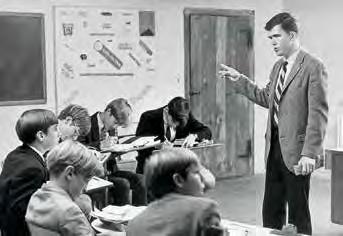
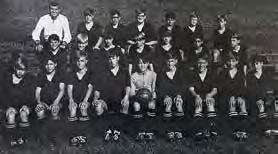
Top. Students at the blackboard in the 1960s // Above. Teacher Tom Dodd teaching in the 1970s // Above Left. Student performing in 1968 theater production // Above Right. Alex (first row, second from right) on First Team soccer in 1968 // Right. Alex today volunteering at the local food bank in preparation for the holiday season // Opposite Bottom. The first students to use the new science classrooms from the Hickrill Science Building acquisition
When Harvey Welcomed
Girls to the Family' By Chris Del Campo
Top. Yearbook photo of Anita Elkind Pomerantz ’84 // Bottom. Yearbook photo of Leslie Altman Weissman ’84
For the students attending Harvey today, and for some of the younger alums, it must seem very strange to think there was a time in the history of their school when it was only boys who sat in classrooms, played on sports teams, and made their way from building to building. Consider how strange it had to be for the small number of girls who arrived each fall in the early years of the 1980s, knowing they would find themselves vastly outnumbered by the boys. You might think the girls were made to feel like outsiders or intruders, but what they found was a school ready and willing to welcome them to the learning community whose members felt quite at home on Harvey’s beautiful bucolic campus.
“Harvey was like a family in the early ’80s,” said Leslie Altman Weissman ’84, one of only seven girls in her grade when she joined Harvey’s sophomore class in 1981. “We all looked out for one another … there was no excessive competitiveness, and we usually traveled in a multigrade group.” Leslie’s classmate, Anita Elkind Pomerantz, shared a similar sentiment. “I recall the boys as very welcoming,” Anita said. “The class sizes were so small that we really all had to be friends with one another, and the adults actually were, by and large, helpful, respectful, and approachable.”
Girls had first enrolled in September 1979 in a newly added sophomore class as part of Harvey’s plan to establish a four-year Upper School program by the fall of 1981. It was not until 1984 that the Middle School started admitting girls. The girls and the first sophomore class might have arrived a year earlier if not for a pair of fires in the main building. The second one destroyed the newly repaired Sylvan Hall, forcing the school to focus its attention in 1977–78 on fundraising and constructing its replacement. Headmaster Harry Dawe, undaunted by the setback of having to deal with the aftermath of the second fire, displayed his great vision and extraordinary leadership in rallying his administrators and faculty to forge ahead with discussions on the idea of expanding the school by enrolling girls, adding the upper school grades, and constructing new campus facilities.
As it is with every school that undergoes significant changes to its program, Harvey’s administrators and faculty were dealing with two monumental changes — going coed for the first time in the school’s long and storied tradition and enrolling high school students for the first time since the late 1920s.
Retired Latin teacher Tim Stark was very much in the thick of things during the 1980s when Harvey was welcoming girls, while at the same time building an upper school program. Mr. Stark, after whom the school’s Stark Fields on lower campus are named, was one of Harvey’s longest tenured and most beloved teachers



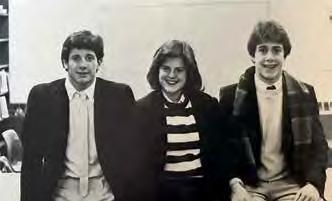
Top Left. Anita with fellow student council members // Top Right. Pamela Nicholson Henderson ’84, Noelle Savarese ’85, Kimberly Delaney Johnson ’86, Barbara Daniel ’84, Anita, and Stacy Director Werner ’84 // Middle. Leslie with friends at Harvey // Bottom. Anita and Leslie with their classmates at Harvey’s Centennial Homecoming in 2016: Chip Taylor ’83 (back left) and Nanette Baratta ’82 (front right) join the Class of 1984 (back to front from left to right): Barbara Daniel, Leslie, Alan Rohe, Anita, Herb Sloan, Tom Ellis, Frank Baratta, Steve Walsh, Mark Dolan, and Francis Valentine

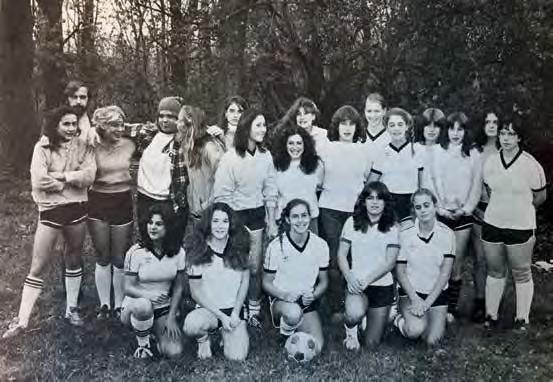

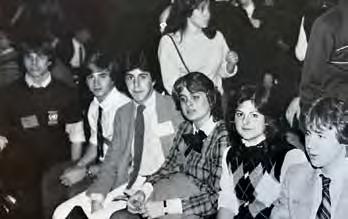

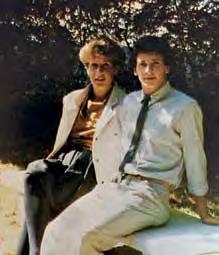
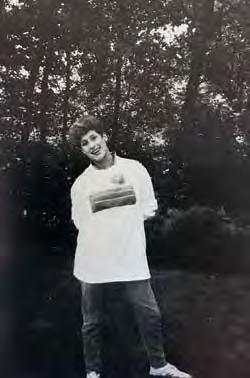
Top. Anita (first row on left) playing with the Harvey girls soccer team // Middle Anita (second from right) with classmates // Bottom Left. Leslie and Frank Baratta ’84 // Bottom Middle. Leslie is all smiles on campus // Bottom Right. Anita as a Harvey cheerleader
(continued from page 20)
and coaches. He recalls how the teachers felt about moving away from a traditional all-boys pre-prep school to becoming coeducational. “The vast majority of the faculty eagerly supported the notion of admitting girls into the school even though there was some apprehension and uncertainty,” Mr. Stark said. The school had work to do to accommodate having girls share the campus with the boys. Headmaster Dawe and his staff had to find space to locate girls’ restrooms throughout the school, establish a dress code for the girls at a time when boys were required to wear jackets and ties, create extracurricular activities that would interest girls, and construct a new locker room just for girls across from the steps to McConnell Gym. One other thing that caused much discussion was how to deal with academic and social infractions. It was thought that the Walk List didn’t seem to work as well with girls. The age-old tradition of giving demerits, which then had to be “walked off,” evolved into creating a review board with students as well as faculty adjudicating matters of student infractions.
The arrival of the girls also prompted some teachers to amend their lesson plans and teaching styles. “One of the first things I noticed about the girls in my Latin classes was that they could sit quietly and pay attention for longer periods of time than some of the boys,” shared Mr. Stark. “Using examples and analogies from professional wrestling did not resonate with them and reading extensively from Caesar’s ‘Gallic Wars’ was not exactly their cup of tea either,” he quipped.
Leslie appreciates how much the faculty made her feel welcomed and how attentive they were to the needs of her schoolmates. “There was an overwhelming sense that the faculty cared about their students and were equally invested in the outcome of their future plans,” Leslie said. She recalls feeling a strong sense that both teachers and students alike fostered a nurturing learning community. “Students took advantage of their teachers’ office hours for extra help, and they also actually helped each other with their work rather than see it as taking away from their marks if other students were also successful,” she added.
In sports, the school faced the challenge of providing opportunities for girls to compete interscholastically. Some girls, like Leslie, looked forward to playing at a high level while other girls, like Anita, not so much. The school was able to offer only one girls team per season for several years, and the girls generally played at the JV level. Mr. Stark recalls that in the fall, Ron Wilson coached girls soccer, and, a few years later, Dorothy Briggs started a girls field hockey team. When the girls soccer diehards did not have enough players to support their own team, they filled out the rosters of the boys teams. In the winter, the girls formed a basketball team. In the spring, softball was the sport of choice. Harvey’s offerings for girls satisfied Leslie, who played three sports — soccer, basketball, and softball — and went on to play soccer at Hobart and William Smith where she earned a Bachelor of Arts in Art History with a studio and religion minor before going on to NYU for a master’s degree in interactive telecommunications. For Anita, who admits “having no eye-to-hand coordination whatsoever,” she recalls being required to play varsity soccer while not looking to play a sport at a high level, but she was “quite happy to be one of Harvey’s first cheerleaders” and earn sports credit for being on the squad. “Harvey was wonderful in so many respects for me, and I think being a girl there was more of an advantage than a disadvantage,” said Anita, the Class of 1984’s valedictorian. She went on to earn a B.A. from Wellesley College and an MBA from the University of Rochester’s Simon School of Business.
It certainly was not an easy task for the school to extend its mission to include girls and make them feel on equal footing with the boys, given the initial low enrollment numbers for girls in a school steeped in a male-centered tradition for the first 76 years of its now 104-year history. With strong leadership from its headmaster, and with the commitment of a dedicated faculty and staff, the cooperation of the boys in making room for the girls, and the understanding, patience, and resiliency of the first girls themselves, Harvey’s “family” became complete.
In reflecting on those challenging transition years of 1979–84, Mr. Stark feels strongly that the arrival of the girls, whom he calls “pioneers,” provided the finishing touch on making Harvey whole as a learning community, of rounding out a sense of family that so many today say they feel. “The first wave of girls at Harvey deserves much credit for the ultimate success of the coeducational program, and I am so very pleased and proud to spotlight them.”



